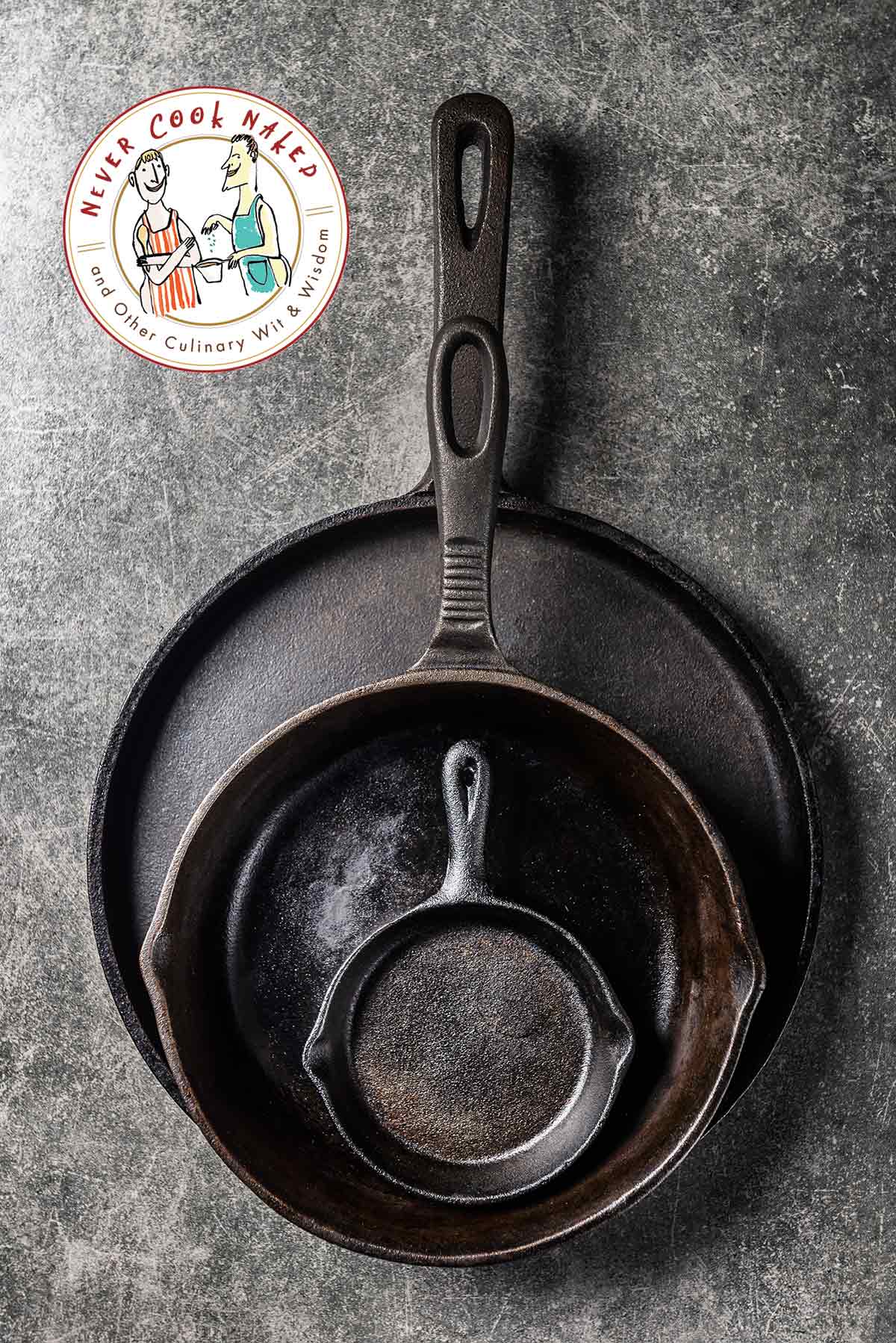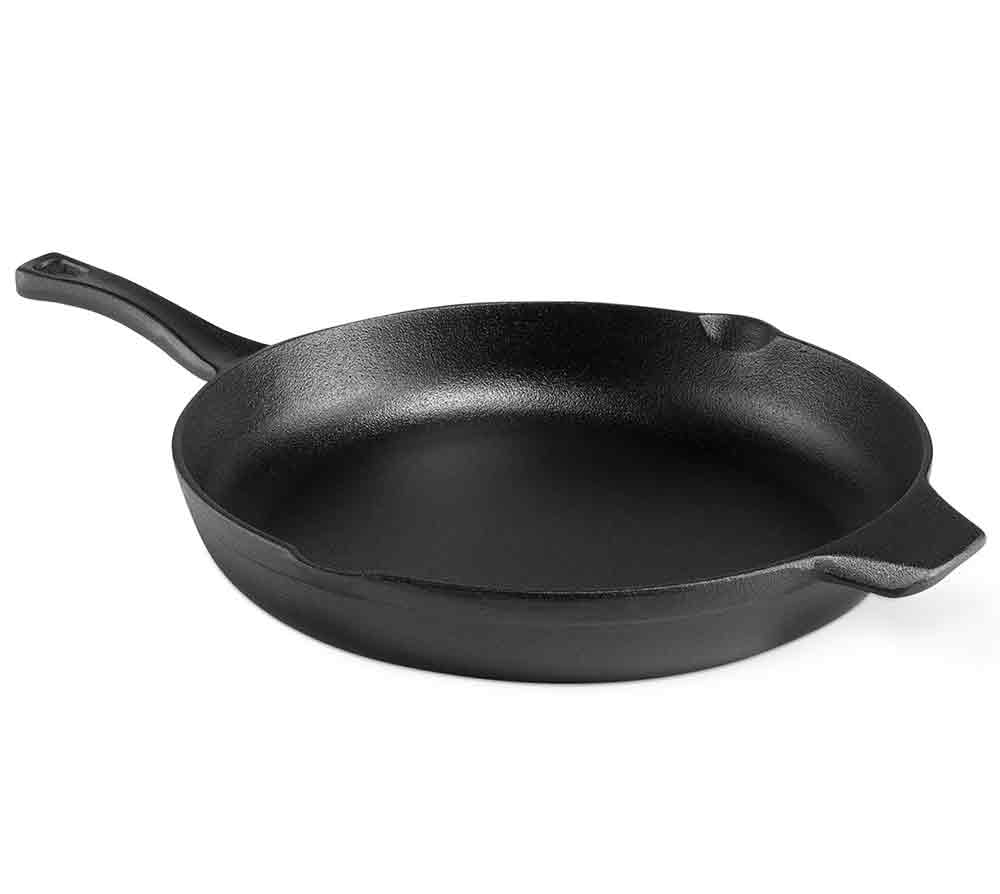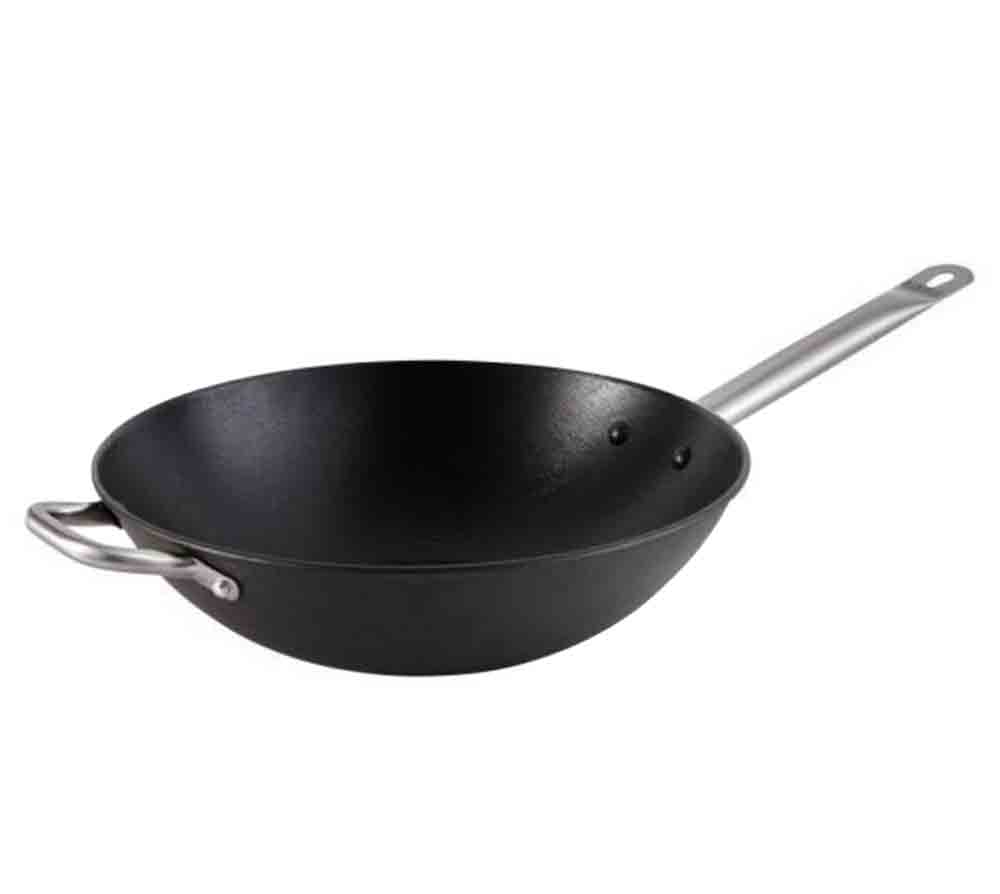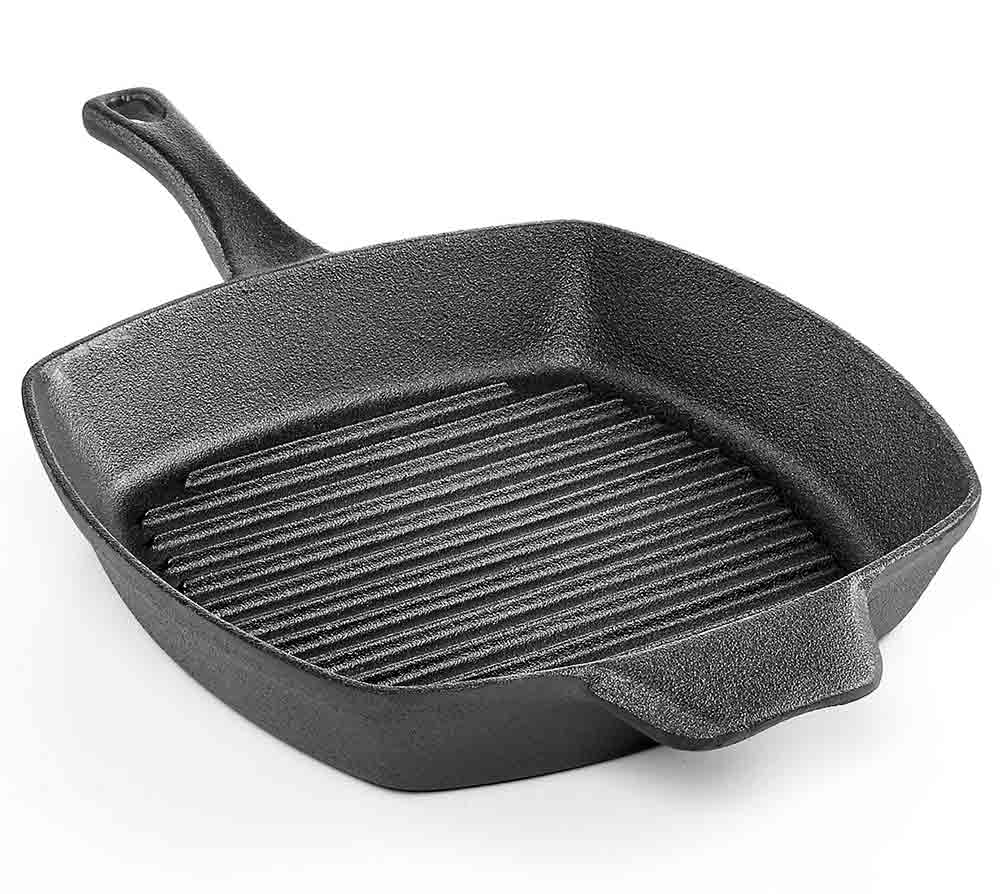
How to Clean Cast Iron Pans
Dear Never Cook Naked Guys: Okay, so what about the great debate over cleaning cast iron pans? To scrub or not to scrub? Soap or no soap?—Clean Freak
Dear Clean Freak: If you ever come to our house and scrub our cast iron cookware with soap, we’re never inviting you back. You can forget about a Christmas letter, too.
Back when one of us was in cooking school and the other was passed out drunk in grad school somewhere, the culinary instructors kept their cast iron omelet pans under lock and key lest any student be dumb enough to wash them. See, the surface of cast iron is a warren of microscopic nicks and gashes. Over time—and after enough frying—fat fills in these crevasses. This creates a smooth, sealed surface, thereby lending the cookware a naturally nonstick finish.
Soap dissolves that prized patina of crud. Wash a nicely seasoned skillet with suds just once and there goes years of work, quite literally, down the drain. Cast-iron cookware should instead be cleaned with coarse-grain salt. Think kosher salt. Pour some in the skillet, add a little warm water, and work the crystals back and forth across the surface with a wadded-up paper towel (leave that sponge in the sink; it may contain some residual soap). You’ll dislodge burned-on bits without destroying the built-up finish. Rinse the cookware, then place it over high heat until it’s smoking to 1. sterilize it, 2. preserve the coating, and 3. dry the pan out completely so the iron doesn’t rust. Cool the cookware to room temp and it’s ready to go.
Do this and you’ll end up with a shiny nonstick surface. Plus, you’ll stay in our good graces. This year’s Christmas letter promises to be more detailed than ever: every meal we ate, every dish we cooked, every vacation we enjoyed, every breath we took. Thrilling. Just thrilling. Originally published August 8, 2013.
Some of our Favorite Cast Iron Pans

Calphalon Pre-Seasoned Cast Iron 12″ Fry Pan
Adding brilliant, robust flavors and precious nutrients to your food, this cast iron beauty comes pre-seasoned and ready to cook. The stick-resistant interior prompts powerful heating & effortless food release. Oversized helper handle. Safe for all stovetops. Oven and broiler safe. Lifetime warranty. $49.99

IMUSA 14″ Wok with Stainless Steel Handles
The IMUSA Wok is a must-have to exploring Asian cuisine. Developed by the Chinese 2,000 years ago, the wok is ideal for quick, healthy cooking. Stir-fry meat, fish, vegetables, poultry and rice over high heat with minimum oil. Made of lightweight cast iron. Pre-seasoned interior. Safe for stovetops, grills, burners, and ovens. $59.99

Calphalon Pre-Seasoned Cast Iron 10″ Square Grill Pan A must-have for indoor grilling. Like the classic skillet above, this cast iron grill comes pre-seasoned and ready to cook. The stick-resistant interior prompts powerful heating & effortless food release. Contoured handle & oversized helper handle. Black matte interior masks staining. Stovetop, oven, and broiler safe. Lifetime warranty. $42.99
Our very clever, very clothed Never Cook Naked columnists are at your disposal, able to troubleshoot everything from questionable table etiquette to tricky cooking techniques (as well as, natch, proper cooking attire). Curious to learn more solutions to culinary conundrums? Just ask! Drop us a comment below.









I used almond flour in a (1234) cake recipe and made perfectly delicious bread less bread pudding. After taking it out of the oven I had to dump the ‘cake’ in a colander and a lot of oil drained from it. What happened? When and how is it ok to use almond flour? (I think the drained oil was almond oil.)
Thank you! Dot
Ps: the breadless bread pudding was delicious and gluten free.
Hi Dot, I wish it was as simple as swapping almond flour for regular flour but it is much more complicated. Almond flour contains more fat and moisture than regular flour, lacks gluten and weighs differently. So in order to swap one for the other, you need to compensate for all these factors. The best thing to do is to stick to a recipe that calls for almond flour. Once you get used to the feel of the batter, you can try to convert some of your regular recipes by adjusting flour and fat amounts and adding ingredients that mimic gluten to add structure.
Addendum….What I do insist upon is that the pan be dried over a flame until completely dry. THIS IS A MUST.
With all due respect, someone needs to challenge this myth that you shouldn’t wash seasoned cast iron pans with a little soap. IT IS JUST NOT TRUE. While this advice is well-intentioned, it is misleading. You do not want to leave the lingering flavor of everything you cook behind! Once a pan is well-seasoned and it has been used to fry food, even if you dislodge any bits that stick and wash it lightly with dishwashing soap, fat will and does remain behind to keep the surface of the pan sealed, and over time it gets better. Although the surface does become almost non-stick, sometimes food WILL stick, and the pan will be need to be scrubbed (and maybe even soaked!!). If in doubt, at any time, a coating of oil may be applied and the pan reheated in the oven to seal any “raw” spots.
If you tell people that they can NEVER wash a cast iron pan, there will be some who end up with some grody, smelly pans. You just have to use your common sense. If you don’t believe me, I’ll be happy to post a picture of mine!
Hi, Kathy. We’re going to stand by the “never” as stated in our article. While you can indeed use a mild soapy detergent to clean cast-iron cookware, you’re really only doing so as a fallback position, even according to Lodge, the maker of most of the cast-iron stuff. Yes, some people don’t want to do the salt-and-water clean-up trick; they feel they might be missing something icky. If they’re worried, they CAN use a mild detergent–with heavy emphasis on the “mild,” as in no grease-cutters in the mix. However, that surface is nonetheless full of nicks and cracks which can catch and hold even mild detergent residue–and which can become a (mildly) soapy blech in dinner. I’d suggest that if your skillet, after repeated uses, is still “almost nonstick,” it’s because you’ve been removing some of the prized gunk that becomes said coating. Again, we pour coarse salt into used pan and work it around repeatedly with a damp paper towel, removing the bits of crud and also polishing (or replenishing) the nonstick coating. We then set the skillet over high heat until smoking–and leave it there smoking for a good minute. Or we put the skillet in a 450 oven for 15 minutes. Voilà, sterilized–and even slicker. We’ve never had an omelet tear. Or a soapy aftertaste in brunch. We’d suggest that’s a testament to proper care.
I STILL stand by my comment, and I should not have said that my pans are “almost” nonstick. They ARE nonstick. If and when I wash one, it is with a dishwashing brush barely passed through soapy dishwater. Another problem with saying NEVER wash them is that it will certainly discourage…because it just seems like a lot of trouble…many people from knowing the advantages/versatility of this wonderful cookware that I watched my grandmother use. The first most important step is seasoning the pans properly at the beginning. I prefer to by raw cast iron, not pre-seasoned. And of course I ALWAYS dry my pans over a flame.